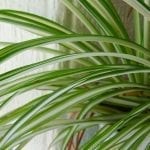
Houseplants to Beautify any Room, Scrub the Air, and Soothe your Soul
Plants bring more life into your home, and there’s just something about them that adds an air of relaxation and style to any room.
But your houseplants do much more than sit there looking pretty: The right houseplant can also filter pollutants such as benzene and formaldehyde out of your home’s air, making it healthier for your family to breathe.
Each houseplant has its strengths, so we’ve made a list of some of our favorites and broken it down into categories: easy houseplants for beginners or the super-busy, beautiful blooms for splashes of color, champion air purifiers, houseplants with striking foliage for a touch of elegance, and edible houseplants that will add beauty to your home and flavor to your table.
Read on to find the perfect houseplants for you!
1. Easy Houseplants for Low-Maintenance Style

Maybe you’re cursed with a “brown thumb,” or perhaps you just don’t have the time or the inclination to do a lot of watering, trimming, and fertilizing. That doesn’t mean you can’t still have beautiful houseplants!
Better Homes and Gardens Magazine recommends these hard-to-kill plants that stay healthy even under tough conditions.
Zee Zee Plant
The zee zee plant (zanizbar gem) is a glossy green succulent with a long life known as the eternity plant. Because it’s a succulent like cacti or aloe vera, it can survive even if you forget to water it for quite awhile. It also does fine in low light, and its thick leaves are so durable that it’s just as sturdy as it looks.
Hoya
The hoya‘s waxy leaves and waxy pink flowers are responsible for its nickname “wax plant.” Hoya’s beautiful blooms have a lovely scent, and this plant can deal with it if you forget to water it sometimes.
Cast-Iron Plant
The cast-iron plant‘s long, wide, pointed leaves can reach up to 2 feet tall, so making it a great floor plant. This plant’s iron-tough constitution is what gives it its name, and the cast-iron plant is every bit as tough as it sounds.
The brawny guy of houseplants, the cast-iron plant can survive infrequent watering, low light, and even a wide range of temperatures. The cast-iron plant is difficult to kill!
Croton
Not only is the croton tough, it’s also absolutely striking (see photo above). The croton’s beautiful multicolored leaves make it look high maintenance, but this easygoing plant is a cinch to grow.
Ponytail Palm
The ponytail palm is actually a succulent, not a palm. This beautiful plant has long, flowing, palm-like leaves that give it its name, and it stores extra water in a wide bulge at the base of its trunk.
Like other succulents, the ponytail palm can go for long periods without water, and can grow quite large: up to 10 feet tall and 4 feet wide. This plant looks gorgeous next to a picture window!
2. Air Purifiers for a Healthy Home

All houseplants convert the carbon dioxide in your home’s air into oxygen, which makes them good to have around, especially during the winter when your house is closed up.
According to This Old House Magazine, Environmental scientist Dr. Bill Wolverton recommends keeping at least 2 houseplants per 100 square feet of living area in your home, to help purify the air.
But these 5 plants do much more than reduce carbon dioxide: They can also filter out potentially harmful air pollutants such as benzene, formaldehyde, and ammonia, and help you maintain a healthy home.
Be sure never to over-water your plants–this can encourage mold growth on the soil and irritate indoor allergies.
Golden Pothos
The golden pothos is a flexible, fast-growing vine with attractive dark green leaves streaked with gold. But don’t let its pretty appearance fool you, because this plant is much more than a decoration.
The golden pothos not only filters carbon dioxide; it also reduces benzene, formaldehyde and carbon monoxide in the air. Because foemaldehyde and carbon monoxide are both components of car exhaust, the golden pothos is the perfect plant to put near the door that leads to your attached garage.
Peace Lily
The peace lily has lovely cream-colored blooms (see photo above) and a graceful appearance. Unlike many houseplants, this beautiful plant can survive in low light conditions.
The peace lily is also a wonderful air purifier, filtering benzene (a carcinogen found in furniture waxes, polishes, and paints) and acetone (an irritant emitted by adhesives, electronics, and some household chemicals such as nail polish remover).
English Ivy
English ivy is a climbing vine that is just the right plant for small spaces such as your office desk or nightstand. Its leaves filter formaldehyde from your home’s air, which Dr. Wolverton says is the most common indoor air pollutant.
In addition to car exhaust, formaldehyde is also found in synthetic carpet dyes, wood floor resins, and other household chemicals.
Lady Palm
The lady palm has a short, spiky, palm-like trunk with long, thin stalks reaching high above it and clusters of pointed leaves at the tip of each stalk. This plant does more than just catch your eye, though: It also catches and filters ammonia, which is an airway irritant and is found in household cleaners, textiles, and dyes.
This plant is an asthma sufferer’s best friend.
Spider Plant
The spider plant‘s long, spiky leaves filter more carbon dioxide than many other houseplants. This humble plant also goes the extra mile, though, and filters benzene and formaldehyde from your home’s air.
Besides having attractive foliage and being an air purifier, the spider plant is also super-easy to grow. A “triple-threat,” the spider plant qualifies for 3 of the categories in this list!
3. Beautiful Blooms for a Splash of Color
African Violet
The African violet is a very popular houseplant for good reason. Its gorgeous flowers come in many striking colors from pink to deep purple and even bi-color, and its velvety leaves are also quite pretty.
The African violet is also easy to grow–all it asks for is some filtered sunlight and warm conditions, and this lovely plant will bloom all year ’round.
Hibiscus
The hibiscus is the classic tropical flower, with giant, round, bright-colored blooms (see the photo at the top of this article). This plant will bloom frequently from late spring through fall, and even sometimes during the winter.
Give your hibiscus plant plenty of light and moist soil, and it will give you a vibrantly colorful show.
Flowering maple
The flowering maple is a flexible plant that you can grow as a shrub, a tree, or even a hanging-basket plant. Its lovely round crepe-paper flowers cover this plant in color, and can be orange, red pink, or yellow.
Oxalis
The oxalis is a very striking, one-of-a-kind houseplant that will make your guests take notice. Its triangular shamrock-like leaves come in a variety of colors, from green with silvery accents, to deep purple (see photo above).
Topping off the unique foliage are delicate clusters of round, 5-petaled flowers that can be white or pink, and that bloom almost constantly. What more could you ask for?
Kaffir Lily
The Kaffir lily, or clivia, blooms during the wintertime, when you most need a spash of color. The clivia blooms in clusters of up to 20 brightly-colored flowers, which can be yellow or reddish-orange.
Keep your Kaffir lily cool and dry, and it will keep blooming. Even when it’s not in bloom, this eye-catching plant’s deep green foliage makes it an attractive choice.
4. Striking Foliage for a Sophisticated Touch
Some plants have foliage that is so eye-catching, they don’t need flowers to knock your socks off. Here are 5 excellent examples.
Peperomia
The peperomia has wide, curvy, multi-colored leaves. The red-edge peperomia is particularly gorgeous–its leaves have green down the middle, surrounded by a rich creamy color, and with a thin red border around the edge of each leaf. Beautiful!
Chinese evergreen
This handsome, low-maintenance plant has green leaves streaked with cream, silver or gray accents. The Chinese evergreen can survive in low-light areas, and looks great on its own or as an accent around the bottom of a taller plant.
Dracaena
The dracaena is a beautiful plant with several long, wide pointed leaves sprouting from a single central stalk. The leaves are green with a golden streak down the middle, and are pretty enough to make blooms unnecessary.
This plant actually fits into 3 categories in this list: it’s easy to grow, has striking foliage, and is also an air purifier. The dracaena filters formaldehyde, trichloroethylene, and xylene from your home’s air. What a hard-working plant!
Dieffenbachia
The dieffenbachia has large, lovely, rounded green leaves speckled with whitish accents (see photo above). In addition to its beauty, the dieffenbachia is also a low-maintenance plant.
Snake plant
The snake plant boasts several tall, glossy, tapering leaves with dark and light green accents, and golden borders. The snake plant’s leaves can reach up to 4 feet tall, and their length give the plant its name.
But the snake plant isn’t just a looker with a cool name–it’s also a succulent, wich means that it can go for long periods without water. Looking for another reason to get a snake plant? This lovely plant also filters benzene and formaldehyde from your home’s air. Sold!
5. Edible Houseplants for Beauty + Yum

While you should assume that most plants are poisonous to people and pets, these houseplants are delicious as well as beautiful. Edible flowers add a classy, colorful beauty to salads, desserts and hors d’oeuvres, and an indoor herb garden helps you add flavor to everything from pasta, to soups, to homemade biscuits.
Check out the lists of herbs and edible flowers below.
Edible Flowers
Some of these delicious blooms are best grown outdoors, and others make perfect houseplants. They’re all yummy!
Indoor Herb Garden
These 5 herbs, including rosemary (see photo above), go perfectly in a variety of dishes, and grow well on your windowsill during the winter. If you like, you can set the pots outside during warm weather.
Photos courtesy of dbgg1979, Hafiz Issadeen, Ezra S F, scott.zona, Maja Dumat, and Health Gauge.












